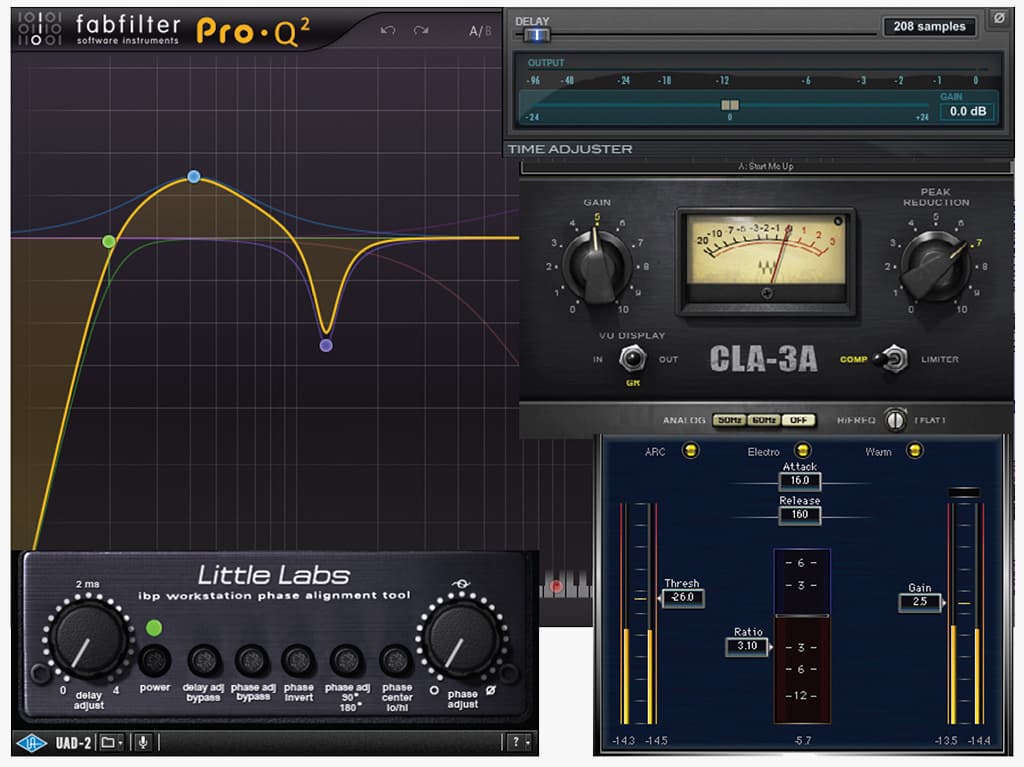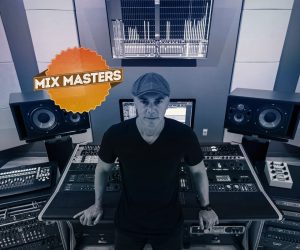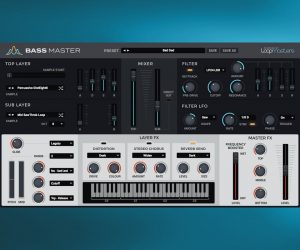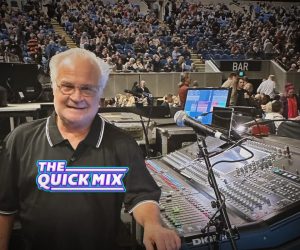
Mix Masters: Beyonce
Making Lemonade With Beyonce's Right-Hand Man, Stuart White

Artist: Beyoncé
Album: Lemonade
B&W Photos: Kenevan McConnon
Jungle City Photos: Ramon Rivas
Beyoncé’s latest album, Lemonade epitomes the adage ‘Hell hath no fury like a woman scorned’. The album addresses infidelity, with Beyoncé on the receiving end. Wounded and angry, the album pulls no emotional punches. Rolling Stone labelled it “an entire album of emotional discord and marital meltdown.” With her hackles well and truly raised by the betrayal, Beyoncé didn’t stop at her own distress, instead she cast the album’s net over broader themes of women’s power and racism on songs like Freedom (with Kendrick Lamar) and Formation, which are the singer’s most politically explicit to date. Beyoncé has responded to life’s basket-case-full of lemons by serving up some pretty tart Lemonade.
Just like Beyoncé’s previous self-titled album, Lemonade was released with complementary full-length visuals. While the former had individual music video accompaniments, the new album settles in with an hour-long art movie consisting of 11 chapters. It moves from Intuition to Denial to Anger, eventually ending with Hope and Redemption. Each chapter contains a song, and in between the songs Beyoncé narrates poignant texts like “You remind me of my father, a magician, able to exist in two places at once. In the tradition of men in my blood you come home at three a.m. and lie to me. What are you hiding?” Not exactly a bundle of fun.
Clearly, Beyoncé had some lemons to grind. Her process in creating Lemonade involved working with tons of producers (about 20) and co-writers (more than double that amount). Some of the co-writers were big names who also feature in the songs, like Jack White, The Weeknd, James Blake, Kendrick Lamar and Marcus Miller. Likewise, some of the producers are also well known names, like Diplo, Mike Dean, Hit Boy, and Just Blaze. Beyoncé also brought in many up-and-coming young producers and executive produced the album herself.
MAN IN THE MIDDLE
The resulting 12 songs that appear on Lemonade (the extra song, Formation, plays during the movie’s credits) are a kaleidoscope of musical genres. We’re talking R&B, rock, soul, hip-hop, pop, blues, gospel, trap, psychedelia, avant-garde, even samples from early 20th century folk recordings by John and Alan Lomax. It’s an incredibly diverse range of collaborators and musical influences to hold together. The basic material from which the songs were drawn must have run into hundreds of hours. To help her in this complex process, Beyoncé opted to have one engineer, mixer and occasional co-producer at her side the entire time. Artists relying on personal engineers and mixers has become increasingly common in R&B, other examples being Justin Bieber’s engineer and mixer Josh Gudwin (see issue 114), The Weeknd’s right-hand man Carlo ‘Illangelo’ Montagnese, and Lil’ Wayne who has for many years been assisted by mixer and producer Fabian Marascullio.
In Beyoncé’s case, Stuart White has worked as her full-time engineer since 2012. However, being the personal music and studio support to the world’s biggest female pop/R&B star was far from White’s mind when he was 10 years old in North Carolina bouncing tracks between a double tape deck and a karaoke machine. His life only started heading in that direction once he copped a photo of a recording studio with an SSL on the back of his cousin’s CD.
“It fascinated me immediately,” recalled White, “and I wondered how I could end up working in a studio. However, I was still in North Carolina, and any recording studios seemed a million miles away. I did buy two turntables, DJ’d obsessively, and bought a sampler and an 8-track recorder. I went to Full Sail University in Florida when I was 21, did the year program, graduated in 2002, and moved to New York where I was hired by Quad Studios. I later worked with Russell Elevado off and on for about a year, which changed my life. He opened up a whole world of the creative side of engineering for me.”
At Quad, White met engineer Ann Mincieli, who he says was, “probably the biggest influence on my career. She knew her shit inside out, so I stuck to her like glue, and assisted her. She worked with Alicia Keys, who ended up buying her own studio, and Ann invited me to come and work there as well. I ended up staying there for six years. It was a very creative time, because Ann was buying guitar pedals, amplifiers, crazy microphones, all kinds of stuff, and Alicia was really getting into experimentation and a whole new approach to making R&B records. That and my experiences with Russell showed me there’s more to recording R&B/hip-hop than just two keyboards and an MPC! Manny Marroquin and Tony Maserati mixed many of Alicia’s records, and they both were big influences on me as well. Alicia’s producer, Kerry ‘Krucial’ Brothers, then took me on as his personal engineer/mixer. That’s where I really cut my teeth mixing.”
I’ve come to the point where I can often tell from Beyoncé’s body language what she is about to do next

FROM THE JUNGLE TO A MADE MAN
In 2010, Mincieli opened up Jungle City Studios. Around the same time White went back to New York and worked both as a freelancer and Jungle’s main house engineer. Two years later Mincieli told him Beyoncé was looking for an engineer, and when the call came, White “couldn’t turn it down.” He was quickly thrown in the deep end with the recordings for Beyoncé, and confronted with production methods that were both on an industrial scale and highly experimental. “She rented a mansion with 40 bedrooms, and brought many of the world’s best producers out there so everyone could live in the house for a month,” he recalled. “My then assistant Rob Suchecki and I shipped tons of gear there and set up seven studios in the house. The idea was to do the entire album in a month and a half, but in the end it took a year and a half. Beyoncé and I were in the studio together every day for that time.”
Spending day after day with Beyoncé in a studio requires far more from White than just being good at engineering. Having cut his teeth working several years with Alicia Keys, and having been mentored by Ann Mincieli, White clearly knows a thing or two about dealing with top level creative people, particularly women. “The level that these artists work at, they really need to have somebody around them whom they trust,” explained White. “You’re in the room and hearing many different personal conversations. You’re also handling all these files, which are big business. These artists also don’t want to have to explain what they want to do every time. They almost want you to read their minds. Eventually you learn to do that, and I’ve come to the point where I can often tell from Beyoncé’s body language what she is about to do next.”
Over the last four years 90% of White’s work has been with Beyoncé, leaving him only occasional time to work on other projects. However, his credit list since 2012 still includes impressive names like Sia, Nicki Minaj, FKA Twigs, and Boots.
Work on what was to become Lemonade started in 2014, after Beyoncé finished her Mrs Carter Show world tour. No mansions were rented this time. Instead Beyoncé wrote in stages before retreating with White to her house in Los Angeles. The project was once again on an industrial scale, with the involvement of many different producers, and even more experimental than for her previous album.
White: “We started in August 2014 at the Record Plant in Los Angeles. We were there for a month and had booked every single room; producers were everywhere writing songs. After that we took a break, then went to Paris for 45 days, where we lived in a hotel and set up two studios in two different hotel rooms. The identical setups consisted of ProAc Studio 100 monitors, an Avid Omni converter, Telefunken Elam 251 mic, an Avalon 737 mic pre, Tube Tech CL1B compressor, a Shure SM58 which she likes to use occasionally, and matching Pro Tools sessions. I tended to work with Bey in one room, while my assistant, Ramon Rivas, would work with Jay-Z in the other room. Bey and J often work at the same time, which is why we needed two systems.
“After the New Year we went back to LA, to be in the sunshine, also Bey had to perform at the Grammy Awards ceremony in February. So we set up a studio in the movie theatre at her house. In addition to the gear I mentioned earlier, I set up an ASC AttackWall for the acoustics. I’m a big fan of that, and have it in my own studio in New York as well. I lived in a hotel close by her house for a year, and every day they’d text me early in the morning asking me to arrive at a specific time. We would sometimes start as early as eight o’clock. She’s a mother, and if her baby is up at seven, she’s ready to start work at eight! We later also conducted recording sessions at Conway, Henson, Pacifique, Jungle City Studios and Capitol Studios.”
MIX FROM NIX
The different producers and co-writers involved in the making of Lemonade would sometimes send in their material, other times White was involved in recording it. In the case of James Blake, White recorded him at Conway Studios. White: “He came in, heard the track (Forward), walked up to Bey’s Elam 251 with the same vocal chain (Avalon 737 into Tube Tech CL1B) and sang his vocal pretty much right off the bat. Then he tried some chords on the piano and I recorded him soon after using two older Schoeps W-221 small diaphragm microphones going into Neve 1073 mic pres.
“Jack White sent his stuff in for the song Don’t Hurt Yourself, which was recorded on eight-track analogue, with tons of bleed. I love bleed, as it helps glue the track together and creates depth. The thing was, they’d taken all the effects off in the transfer to digital. It was a lot of work for me to get it to fit in our sonic world and make it rock at the same time. We added some samples to beef up the drums and make them fit in our big bass world. Bey sang through a Shure SM58 with distortion and the speakers turned up really loud, like Bono. The 8-track definitely gave it a colour and a mood, then we brought it into our more modern production aesthetic.”
White’s work of bringing all the sonically disparate tracks into that modern production started from the moment he received or recorded any material. “I don’t waste any time,” he said. “Basically, I immediately start mixing; EQ-ing, adding effects, creating moods and sounds. In part, this is to help Bey find the right voice for a song. She changes her voice quite a bit from song to song, so I just go with my gut in the moment then add more and more tweaks every day until we get down to the final mix.
“Things changed constantly. Sometimes I copied a Pro Tools session five times to accommodate five different arrangements. We were changing things right down to the last minute when I printed the mixes and had to turn the album in. It didn’t necessarily involve extensive mix changes, it was often a matter of adding a section, or changing a part of an arrangement or vocal line. By the end the mixes were pretty dialled in, even though we had a separate mix stage at Pacifique studios in LA. I was there for several weeks, and finished off the songs I mixed for the album.”
IN THE LAPTOP BOX
White ended up mixing eight and a half songs on the album — the half was a co-mix of Formation with Jaycen Joshua — while the other three were mixed by Tony Maserati. Central to the entire process was White’s ability to do the entire project on a laptop. “Up until that point I was still using each studio’s desktop computer,” he explained, “but that became hell, because studio computers don’t have the same plug-ins, and I’m plug-in crazy. Every time we went to another studio I’d spend two days getting all the right software. Then we’d need extra cards to run the sessions. It was a huge headache. I went completely in the box a long time ago, probably around 2006. Until the Lemonade project I was tracking everything in the box, but still mixing on a console. However, all the recalls and moving around all the time — all part of the modern way of working — made that more and more difficult.
“I knew if I was going to be a mixer, I’d need to be able to get my best results in the box. It’s absolutely the future. It was like: this is my generation, I need learn to do this in order to survive. It’s a different approach to mixing, but you can get great results both ways. Mixing on a desk sounds different to mixing in the box. When I was working with Russell Elevado my ears were tuned to analogue, but there’s so much innovativation happening now that can’t be done in the analogue world, and I want to keep pushing forward. Digital has a crisp tone and texture that I’ve come to love. Analogue smears the transients and dulls the rough edges, which can sound great too but a lot of engineers have figured out how to work with the digital medium, and make sure it doesn’t sound harsh.
“Also, I strongly feel that an engineer’s job is to make the technology disappear for the artist, so he or she can just be creative. Working in an analogue environment with gear that is inconsistent and changes from studio to studio is a challenge. We work really hard to get something to sound a certain way, and we don’t want to lose that when we have to recreate it elsewhere. Artists certainly don’t like that. They also want to work on things when their ideas are fresh and the energy is new. Working in the box allows me to make the technology disappear for the artist. They can get their ideas down without having anything to worry about.”























thanks, nice article, please provide hi res pictures, that would be even better